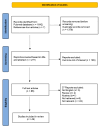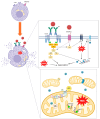Oxidative Stress and Mitochondria Are Involved in Anaphylaxis and Mast Cell Degranulation: A Systematic Review
- PMID: 39199166
- PMCID: PMC11352116
- DOI: 10.3390/antiox13080920
Oxidative Stress and Mitochondria Are Involved in Anaphylaxis and Mast Cell Degranulation: A Systematic Review
Abstract
Anaphylaxis, an allergic reaction caused by the massive release of active mediators, can lead to anaphylactic shock (AS), the most severe and potentially life-threatening form of anaphylactic reaction. Nevertheless, understanding of its pathophysiology to support new therapies still needs to be improved. We performed a systematic review, assessing the role and the complex cellular interplay of mitochondria and oxidative stress during anaphylaxis, mast cell metabolism and degranulation. After presenting the main characteristics of anaphylaxis, the oxidant/antioxidant balance and mitochondrial functions, we focused this review on the involvement of mitochondria and oxidative stress in anaphylaxis. Then, we discussed the role of oxidative stress and mitochondria following mast cell stimulation by allergens, leading to degranulation, in order to further elucidate mechanistic pathways. Finally, we considered potential therapeutic interventions implementing these findings for the treatment of anaphylaxis. Experimental studies evaluated mainly cardiomyocyte metabolism during AS. Cardiac dysfunction was associated with left ventricle mitochondrial impairment and lipid peroxidation. Studies evaluating in vitro mast cell degranulation, following Immunoglobulin E (IgE) or non-IgE stimulation, revealed that mitochondrial respiratory complex integrity and membrane potential are crucial for mast cell degranulation. Antigen stimulation raises reactive oxygen species (ROS) production from nicotinamide adenine dinucleotide phosphate (NADPH) oxidases and mitochondria, leading to mast cell degranulation. Moreover, mast cell activation involved mitochondrial morphological changes and mitochondrial translocation to the cell surface near exocytosis sites. Interestingly, antioxidant administration reduced degranulation by lowering ROS levels. Altogether, these results highlight the crucial role of oxidative stress and mitochondria during anaphylaxis and mast cell degranulation. New therapeutics against anaphylaxis should probably target oxidative stress and mitochondria, in order to decrease anaphylaxis-induced systemic and major organ deleterious effects.
Keywords: anaphylactic shock; anaphylaxis; antioxidant; mast cells degranulation; mitochondria; oxidative stress; reactive oxygen species (ROS).
Conflict of interest statement
There are no conflicts of interest.
Figures






Similar articles
-
Jacareubin inhibits FcεRI-induced extracellular calcium entry and production of reactive oxygen species required for anaphylactic degranulation of mast cells.Biochem Pharmacol. 2018 Aug;154:344-356. doi: 10.1016/j.bcp.2018.05.002. Epub 2018 May 24. Biochem Pharmacol. 2018. PMID: 29802828
-
Leaves and pseudostems extract of Curcuma longa attenuates immunoglobulin E/bovine serum albumin-stimulated bone marrow-derived cultured mast cell activation and passive cutaneous anaphylaxis in BALB/c mice.J Ethnopharmacol. 2024 Mar 1;321:117529. doi: 10.1016/j.jep.2023.117529. Epub 2023 Nov 30. J Ethnopharmacol. 2024. PMID: 38042384
-
Anti-allergic activity of 2,4,6-trihydroxy-3-geranylacetophenone (tHGA) via attenuation of IgE-mediated mast cell activation and inhibition of passive systemic anaphylaxis.Toxicol Appl Pharmacol. 2017 Mar 15;319:47-58. doi: 10.1016/j.taap.2017.02.002. Epub 2017 Feb 4. Toxicol Appl Pharmacol. 2017. PMID: 28167223
-
Mechanisms Governing Anaphylaxis: Inflammatory Cells, Mediators, Endothelial Gap Junctions and Beyond.Int J Mol Sci. 2021 Jul 21;22(15):7785. doi: 10.3390/ijms22157785. Int J Mol Sci. 2021. PMID: 34360549 Free PMC article. Review.
-
Anaphylactic Degranulation of Mast Cells: Focus on Compound Exocytosis.J Immunol Res. 2019 Mar 18;2019:9542656. doi: 10.1155/2019/9542656. eCollection 2019. J Immunol Res. 2019. PMID: 31011586 Free PMC article. Review.
Cited by
-
The Potential Role of Helicobacter pylori-Related Mast Cell Activation in the Progression from Gastroesophageal Reflux to Barrett's Esophagus and Esophageal Adenocarcinoma.Microorganisms. 2025 Aug 12;13(8):1883. doi: 10.3390/microorganisms13081883. Microorganisms. 2025. PMID: 40871387 Free PMC article. Review.
-
Exploring the anti-anaphylaxis potential of natural products: A Review.Inflammopharmacology. 2025 May;33(5):2589-2622. doi: 10.1007/s10787-025-01685-2. Epub 2025 Mar 19. Inflammopharmacology. 2025. PMID: 40106030 Free PMC article. Review.
References
-
- Guerci P., Tacquard C., Chenard L., Millard D., Soufir L., Malinovsky J.-M., Garot M., Lalot J.-M., Besch G., Louis G., et al. Epidemiology and Outcome of Patients Admitted to Intensive Care after Anaphylaxis in France: A Retrospective Multicentre Study. Br. J. Anaesth. 2020;125:1025–1033. doi: 10.1016/j.bja.2020.08.024. - DOI - PubMed
Publication types
LinkOut - more resources
Full Text Sources
Research Materials

